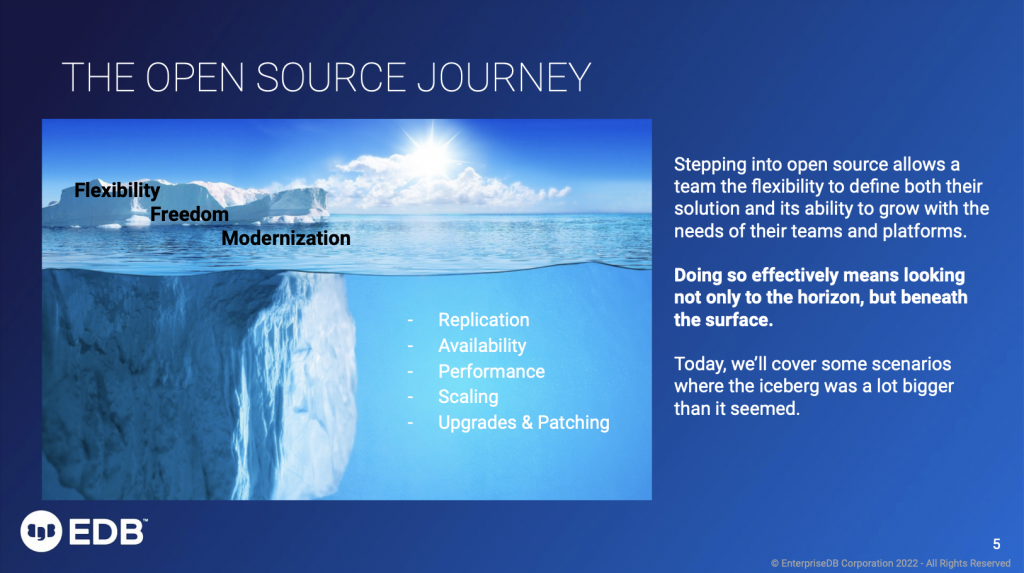In the modern business landscape, your database is the heart of your IT stack. It protects your data, undergirds your operations and ensures that your teams—from developers to sales people—can accomplish their jobs and keep your enterprise running. As such, it’s essential to take the design, maintenance and management of your database seriously.
Many organizations feel confident that they can do this entirely on their own, especially those who opt for open source database management systems (DBMS) like Postgres. After all, the reason so many businesses choose open source databases is to escape the restrictions of proprietary DBMS providers and experience true freedom and independence. Why would they jeopardize that by entrusting their database support to a third party enterprise support provider?
While this freedom is critical and valuable, forgoing all database support and assistance in pursuit of it can prove to be a grave error. In fact, enterprise database support is often the best way to ensure that you maintain the freedom to fully control your own data by keeping your database running.
To learn more about the struggles businesses face when they choose to manage their Postgres databases alone, EDB Senior Vice President of Support Services Jamie Watt sat down with Senior Principal Support Engineer (and developer of Lasso, LiveCompare and OmniDB) William Ivanski for a two part conversation entitled “Avoid Postgres Distress.”
The first session—“Flying Solo”— is available to watch on-demand for those who were unable to attend. Here, in the first of two recaps, we’ll also provide readers with some key highlights from the discussion and its follow-up!
What makes database management so complex?
Most businesses are largely aware of what they want to achieve when they select their database. They could be looking for a DBMS that powers infrastructure modernization or one that allows them to build a multi-cloud architecture with licensing limitations. Maybe they’re looking to abandon the legacy solution that stripped them of control of their data.

However, many times these high-level priorities obscure the complexities of actually managing a database in a way that will allow the organization to reach their goals. Watt and Ivanski frame this scenario like an iceberg. Above the water, businesses can see the benefits of the solution they’re selecting, but the majority of the iceberg is out of sight, deep beneath the surface.
This portion of the iceberg comprises the technicalities of upgrades and patching, how to maintain high availability, the nuances of replication and much more.
For those enterprises who only focus on the horizon, it can be easy to adopt a solution that you know far less about than you previously thought. The result? You don’t actually know how to effectively achieve everything you set out to.
Postgres support misconceptions
When it comes to open source databases like Postgres, many organizations will brush off the need to invest in additional support resources for a couple of reasons. As previously mentioned, some will view paying for enterprise support as antithetical to adopting a free database to begin with or worry that their support provider might make suggestions that impose on their ability to innovate freely. The other reason is the Postgres community.
The Postgres community is a well-spring of information and expertise, acquired from thousands upon thousands of users and curated by a carefully vetted leadership and development group. Because of Postgres’ longevity and widespread popularity, dozens of forums covering nearly millions of use cases have cropped up over the years. If you have a question about Postgres, someone has probably written about it.
As such, businesses will sometimes decide that the community is an effective substitute for enterprise support, an understandable but frequently untrue assumption. There’s no doubt that members of the Postgres community delight in helping users, new and veteran alike. But there’s a difference between pouring over massive amounts of documentation to find the answer to your question, hoping that it makes sense to you and implementing the solution on your own and calling up a dedicated Postgres expert and getting real-time suggestions and troubleshooting.
Over the course of their session, Watt and Ivanski discuss a number of “Mayday!” scenarios relating to performance, high availability, replication and more. They dig into the highly technical details, discussing how each would be solved—and why doing it solo might not be the best solution.
Supercharge Postgres with enterprise support
For anyone already invested in Postgres or considering Postgres adoption, Watt and Ivanski’s webinar is essential watching (as is Part 2!). Not only do both speakers provide in-depth investigations of essential fixes for a wide range of challenges, but they provide fantastic insights into questions of database management more broadly. How do you find the right database for you? What technical requirements undergird which high-level goals.
Postgres has helped thousands of businesses make the most of their data and build truly modern applications for a modern world. Its dedication to freedom and independence have made possible innovations that enterprises never could have imagined before. But just because you value independence doesn’t mean you have to handle your database alone. Enterprise support will help you supercharge Postgres.
Check out the entirety of “Flying Solo” here!
